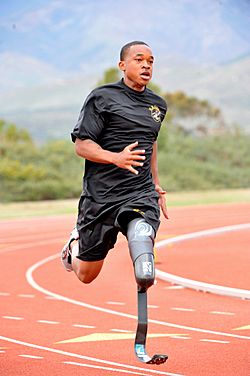Amputation facts for kids
Quick facts for kids Amputation |
|
|---|---|
 |
|
| Sgt. Jerrod Fields, an athlete and amputee |
Amputation is when a body part, like an arm or a leg, is removed. This can happen because of a serious injury, a medical problem, or a surgery. When doctors perform an amputation, it's usually to stop pain or to treat a serious disease in that limb. For example, it might be done if someone has cancer or a severe infection called gangrene in a limb. Sometimes, it's even done to prevent these problems from getting worse.
Amputations can also happen because of serious injuries, like those from accidents or during a war.
In the United States, most new amputations happen because of problems with blood vessels. This is often linked to conditions like diabetes, which can damage blood flow to the limbs.
Many people live with limb loss. In the US, there were about 1.6 million people with amputations in 2005. By 2013, this number grew to 2.1 million. Each year, around 185,000 amputations happen in the United States. Experts believe that by 2050, about 3.6 million people in the US will be living with limb loss.
What is a Phantom Limb?
Many people who have had an amputation experience something called a phantom limb. This means they feel sensations in the body part that is no longer there. For example, they might feel like their missing hand is itching, or their missing foot is aching.
These sensations can include feeling tense, dry, wet, or even like the limb is moving or stuck in a certain position. Scientists think this happens because the brain has a "map" of the body. This map continues to send signals about the limb, even after it's gone.
Life After Amputation
Thanks to amazing new technology, many people with amputations can live very active lives. Modern prosthetics (artificial limbs) are much more advanced, helping people do many things they could before.
Organizations like the Challenged Athletes Foundation help people with amputations get involved in sports. They can participate in adaptive sports, which are specially designed for people with disabilities. An example is Amputee Soccer, where athletes play soccer using crutches and only one leg.
See also
 In Spanish: Amputación para niños
In Spanish: Amputación para niños

